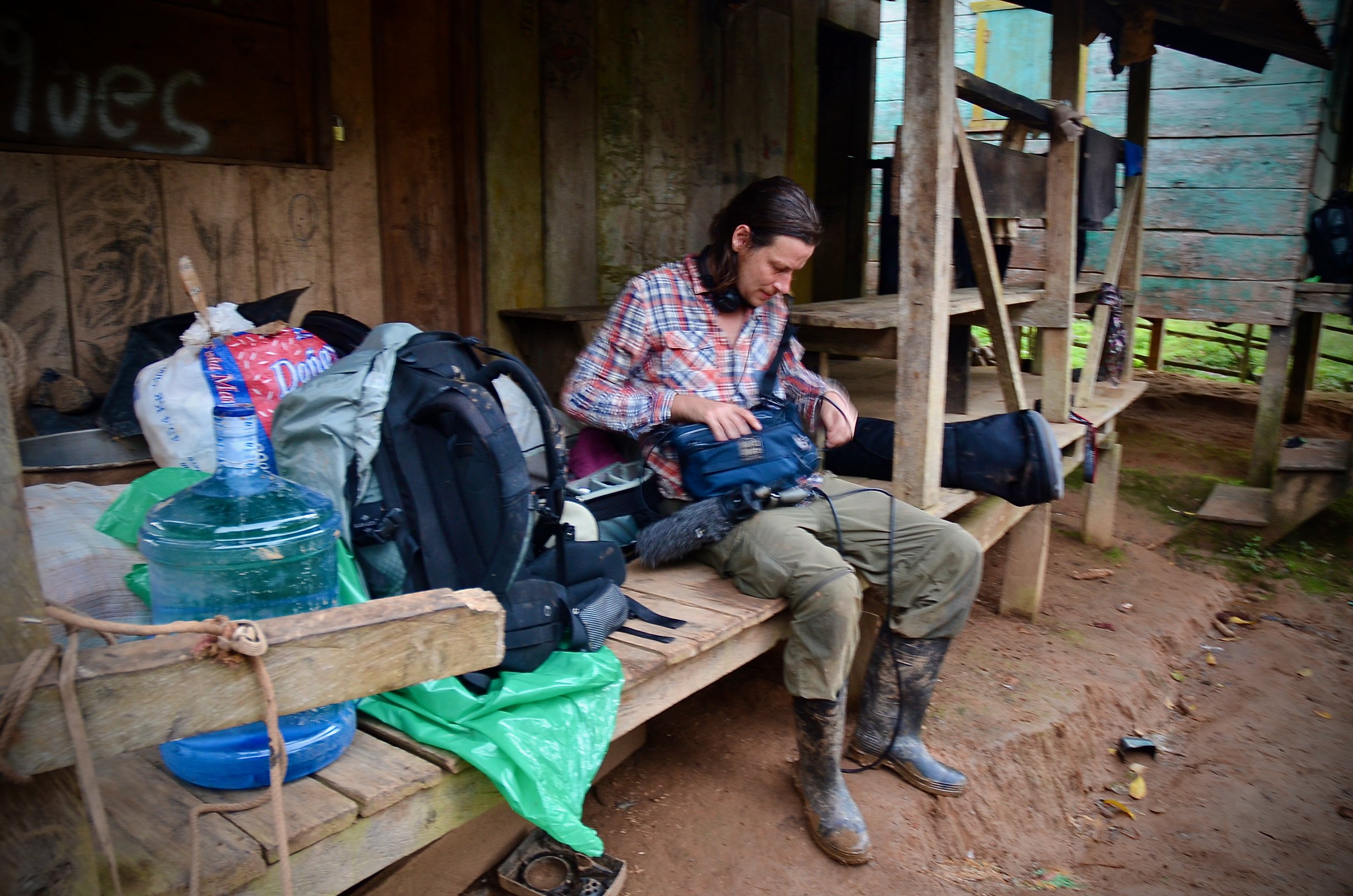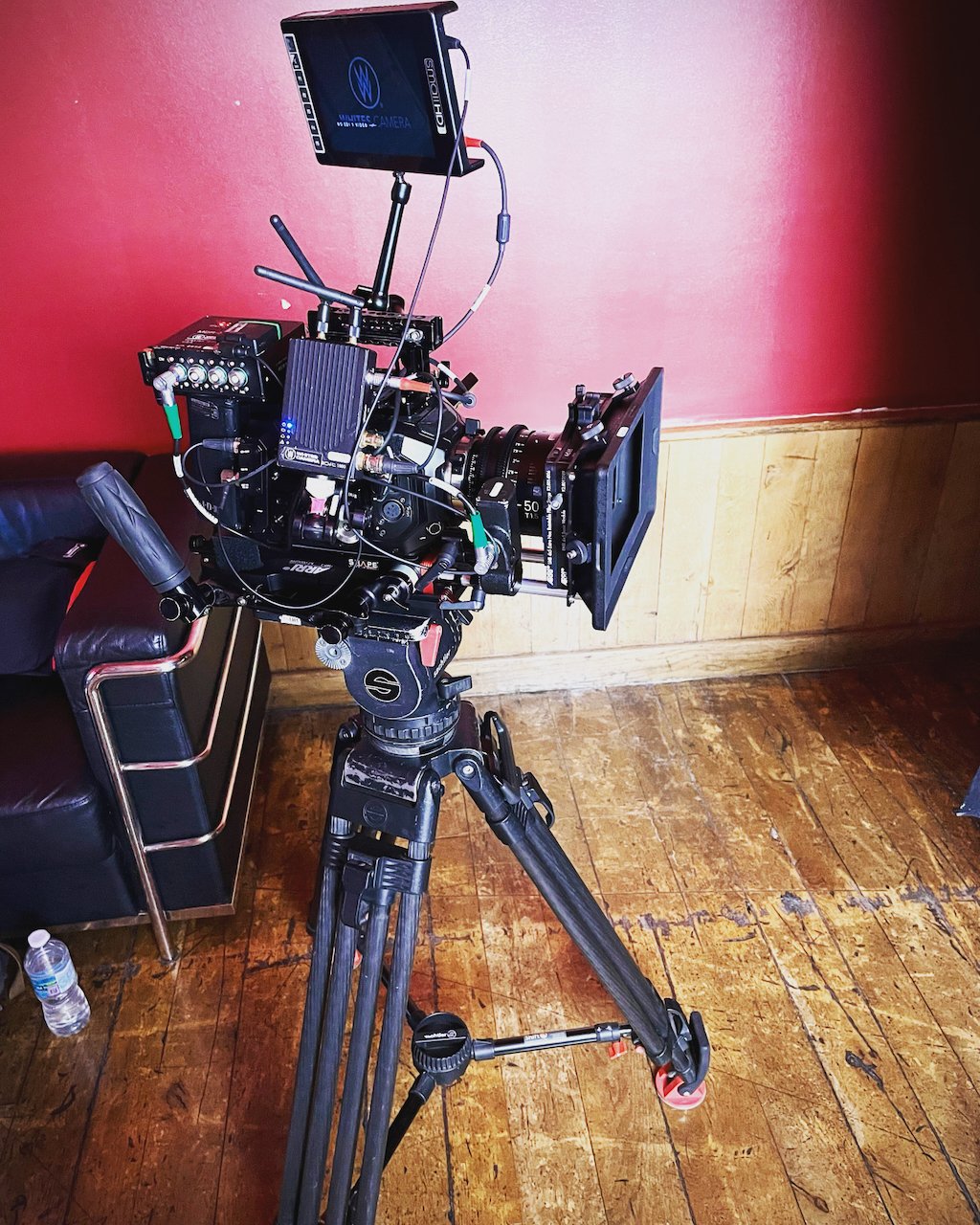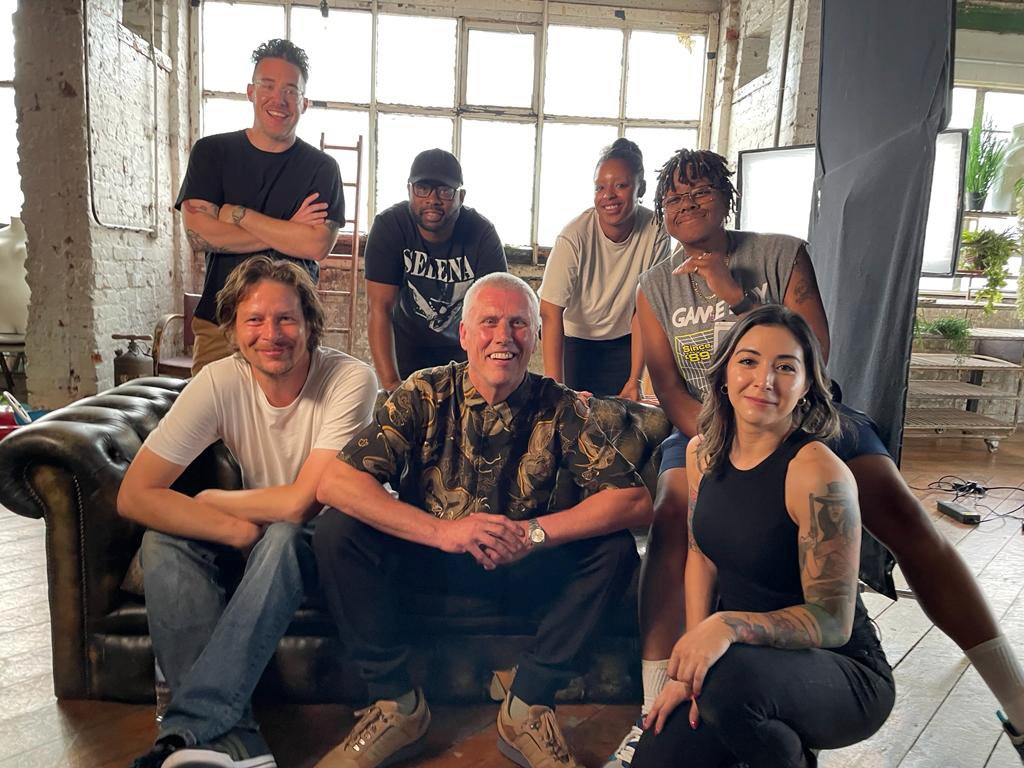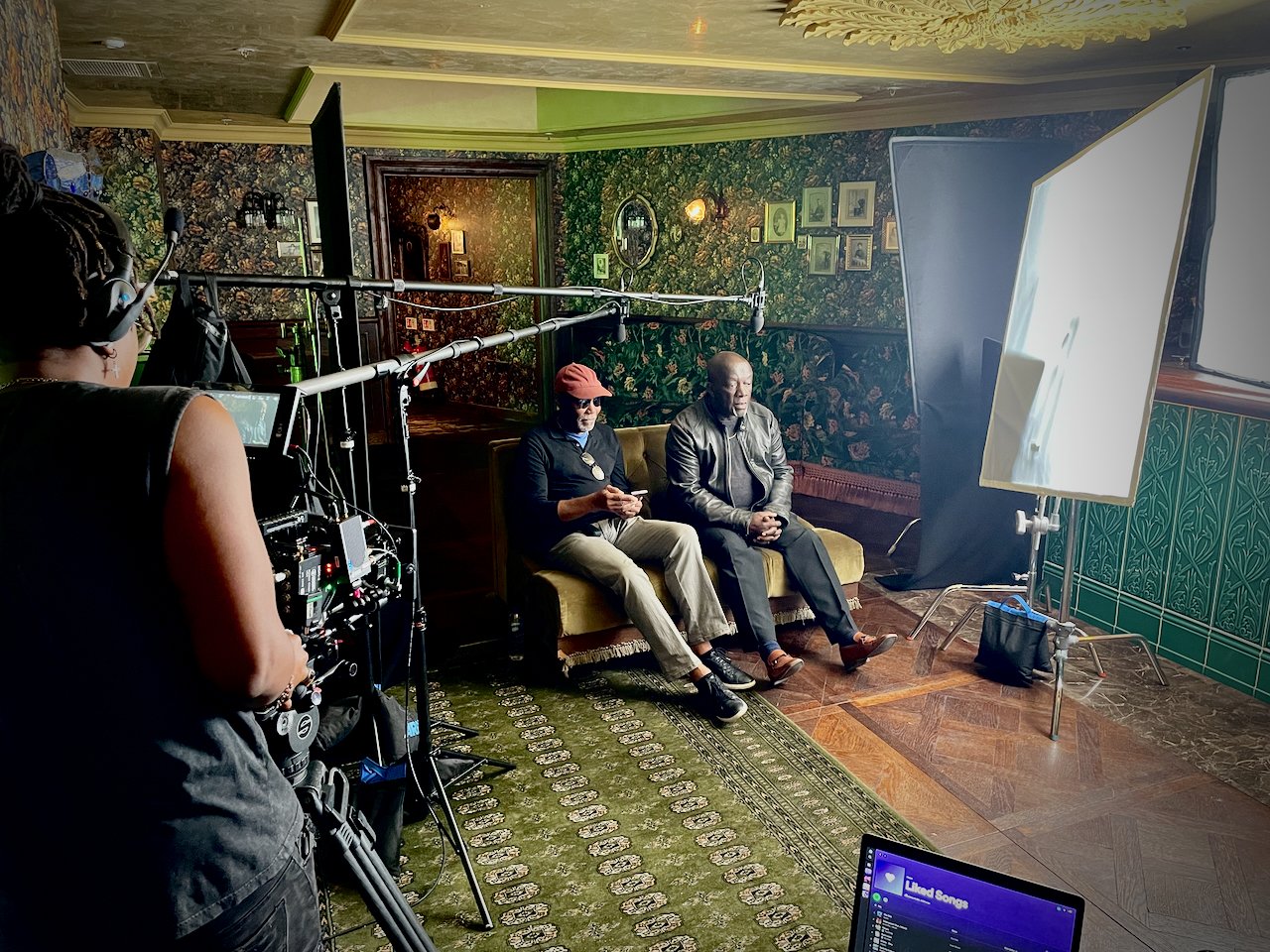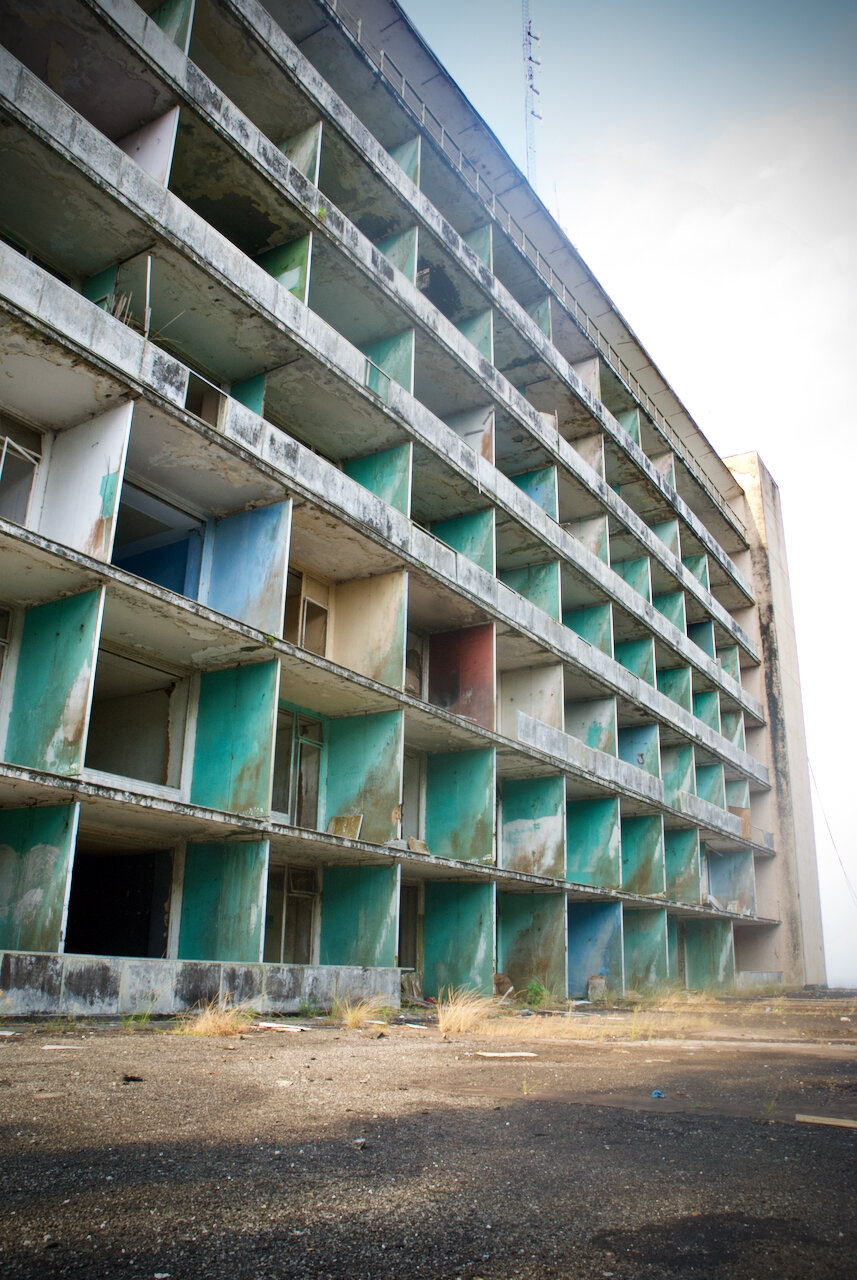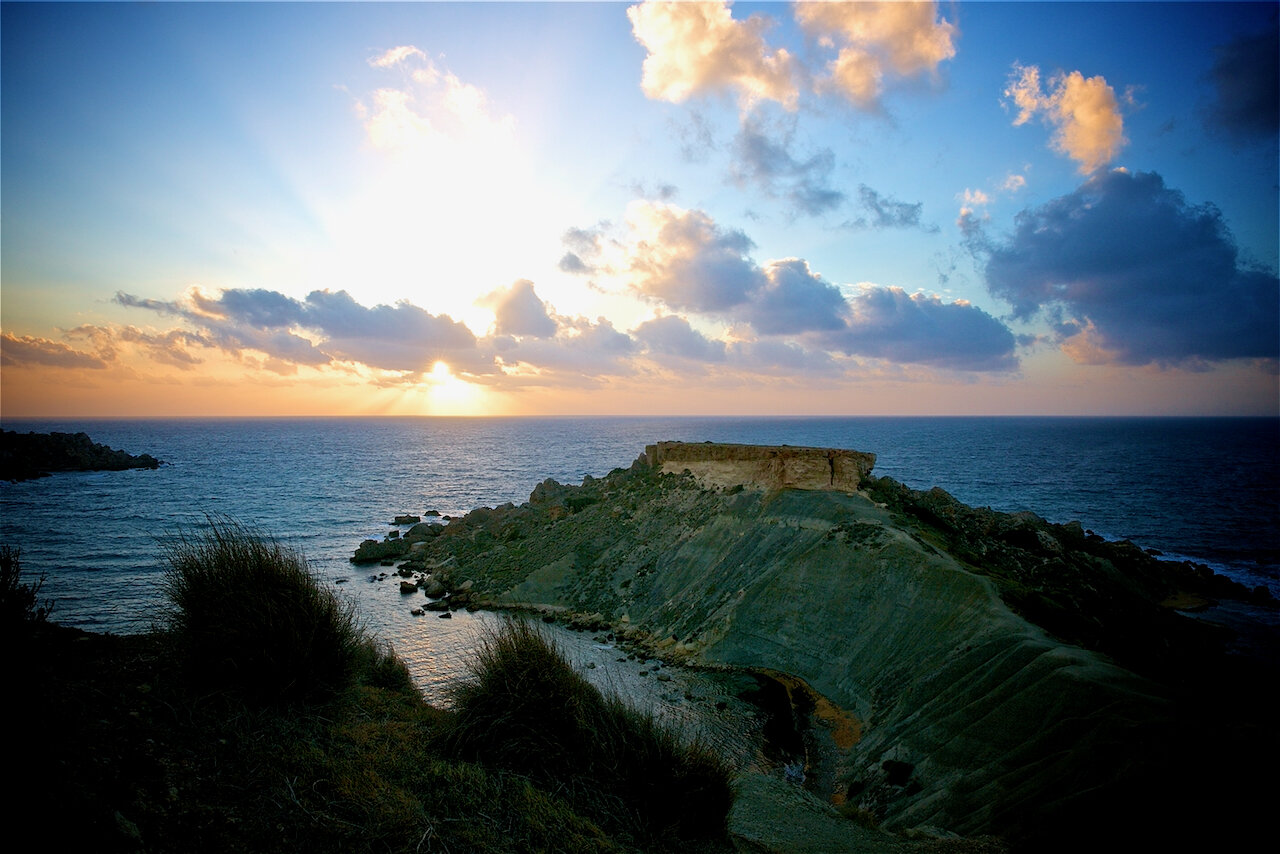Ten years ago deep in the jungles of Nicaragua. Can a memory seem both vividly immediate and simultaneously distant. We’d spent a long day travelling into the Bosawas Biosphere crammed into a single canoe. In the morning we’d experienced incredible showers of tropical rain and then later in the afternoon the heat returned and the sun baked our backs and exposed necks. That evening still a fair distance from our destination we pitched up at our canoe skipper’s small farmstead, a collection of little houses on a hill in the forest, to spend the night. I’m checking everything is working and the wires are all good, after having water sloshing around in the canoe all day, we and our gear were perpetually wet. The challenges of working in rainforests is humidity and moisture, generally speaking everything around you, and our thick skinned waterproof sacks, which we bagged everything into were incredibly useful. They lasted several demanding trips. I still have one of them, the last of three, residing in the kit cupboard by the outdoor gear and hammocks.
Shaw Theatre, London
A special treat, sat high above the stage and audience in the Shaw Theatre just opposite the British Library on Euston Road. There was an interesting debate hosted by the Royal Society of Philosophy, it was being filmed and it required me being upstairs, behind a labyrinth of narrow passages and stairs, tucked cosily in the sound/lighting box with Jo the wonderful lighting guy, recording the speakers. It reminded me of the old days way back studying Technical Theatre back in college when I was a wee lad. Lots of fond memories of long week nights hidden above the theatre stage in the sound/lighting box, usually with a group of young talented hands, all learning the art of theatre, drinking and smoking roll ups. Those first tentative steps into the world of creating and broadcasting.
On the road to Albert Hall, South Kensington, London
Sometimes when you do sound for film and TV you can’t help but feel a little bit like a Christmas tree, there’s so much hanging off of you, or wired and tapped to other people, or clipped into cameras. One vast accessory store for the noises you hear on the TV box, no wonder sound bags these days resemble a portable office, with pockets like drawers and filing cabinets.
Bernard Purdie – drumming in your blood
A few years back I went on an epic journey across the USA filming a four part series for Sky Arts about the world's best drummers. From old blues and jazz masters, maestros of funk and latino, reggae and rock and roll, to modern day punk and thrash metal. We travelled along the Eastern side of the country, driving down from New York and stopping in Philadelphia; then across to snowy Indianapolis and a long drive south visiting drummers in Nashville, Memphis, Mobile, New Orleans; then heading west to Los Angeles. One of the first drummers we filmed on a rainy day in New York was the enigmatic Bernard Purdie, once band leader for the great Aretha Franklin, a drummer who played with James Brown, Steely Dan, Gil Scott-Heron, King Curtis, Miles Davis, Dizzy Gillespie, Quincy Jones, Isaac Hayes, Cat Stevens to name a few. Here he talks about his musical upbringing. I hope you enjoy it.
Sound kit in various exotic places
History of Disco, Paramount Pictures
Unpacking the gear from the crew van the only way down to the basement was through a narrow tiny cell of a lift. A sweltering sweaty place and for the best part of an hour everything needed for filming navigated this small contrivance. The grips and rails, the tripods, the C-stands and flags, the bulky chargers and adaptors, the lights, the cameras, lenses, monitors and trolley, all were squeezed, with varying degrees of swearing into that tiny lift and spread out among the elegant dining space down below.
It’s been a while since this site has been updated. Seeing as a whole lot of stuff has been going on I thought it a good idea while things calm briefly to put some bits and pieces up and show what's been happening. This year has seen some steady and interesting work as a soundie, which is great as it offers me a wide range of work be it broadcast, commercials or corporate. As well as the different parts of the country you end up travelling to and working in, the main pleasure for me is always the people you get to work alongside, some long familiar and dear friends, as well as new partnerships and collaborations. And this gig came through one such dear friend. As is often the case in this industry a friend of mine, a fabulously talented documentary director, mentioned randomly that they had mentioned me to another friend, a producer based in the States, about me being a very nice soundie with a bit of a niche in music documentaries. Which was all very generous and greatly appreciated. I waited to see what would come of it. Soon enough one afternoon a week or so later, the phone rang and there I was talking to the production office at Paramount about collaborating on a project covering the history of disco. It would be executive produced and presented by Nile Rodgers. Needless to say I was beyond excited from the outset, I’d be meeting and working with Nile Rodgers, the man responsible for a plethora of enormous hits, one of the great all time song writers, record producers and musicians. A multi grammy winning artist who pioneered the early sounds of both disco and hip-hop. Also the line up of other interviews seemed like an. unbelievable dream, a calvacade of musical heroes, so I immediately announced my unhesitating availability.
A few weeks later on a gorgeous sunny morning end of June, that most perfect time of the year, and I’m taking a taxi ride down through London to Berkley Square and the elegant private club called Annabel’s in Mayfair. I love these mornings, leaning up against my kit bags, gazing absent mindedly out the window watching people leaving their homes and beginning their commutes, all these lives, all these stories. Then after swift introductions to a cheery but jet-lagged crew from Ontario Canada we are pretty soon humping kit around and shooting a fascinating array of people from the music world. Nile Rodgers was our first contributor, and he gave a long deeply fascinating interview split across a morning and afternoon. He was attentive and generous, a day filled with great stories about his life, America and its history, all fields of music and creativity and of course the birth of disco in New York City in the 1970s. He is quite simply a phenomena, the sheer astonishing array of songs he has written and the artists he has worked alongside. From Diana Ross, David Bowie, Madonna, Beyonce, Lady Gaga. Its always a bit extraordinary to find yourself in these situations. Listening attentively through your headphones, eyes on the levels display of your mixer, immersed in the darkness at the edge of the pools of light thrown by the panels and lamps, aware of the camera crew and director a little to one side, indistinct shapes in the gloom, how lucky you are to be sitting there, to be a part of things like this.
At one point just before the interview begins, with Nile in position, we are doing a final tweak of lights and framing. This is the opportunity for me to position my microphone more succinctly for the contributor. The deal here is to get the microphone as close as possible and at the right angle without appearing in the frame of the two cameras, one which is shooting a wide the other close-up. It’s always - despite its absolute importance - a slightly awkward, slightly absurd job to do. In effect you are balancing something - namely a microphone - inches above someones head, the microphone is attached to a carbon fibre boom pole which is often extended over several metres, this is securely clamped to a sand-bagged light stand, and at the other end of the boom hangs as a counter balance two weighted lastolight bags. The whole thing, in nearly twenty years of doing this, has never fallen on the head of a contributor, although never say never, once in Malibu filming the great drummer Chad Smith, he had theatrically finished a drum fill and raising his sticks above his head had accidentally knocked a dialogue microphone, the sound of which reverberated painfully around my head for a few minutes afterwards. On this occasion however you certainly don’t want your kit falling on the head of one of the greatest living music producers of recent times.
As I’m doing this, and being very careful in the process, I say to the director of photography. “The closer the microphone is, the sweeter the sound.”
To my absolute joy I then hear Nile say gently. “Now that’s the truth.” I look down and for a moment we smile at one another, one of the shortest and yet nicest exchanges I’ve ever had with someone of his stature. Needless to say, we got a great inteview, it sounded magnificent, and nothing fell on Nile’s head.
For a short period we formed a happy little crew as we trailed around London filming back to back interviews, in a variety of locations, Annabel’s the very grand club just off Berkley Square, where I asked for a cup of tea and was given a silver pot and china cup with little jug of milk and sugar pot; an old Picture house in King’s Cross, turned into a venue and nightclub, a terrible place for sound where the Piccadilly line rumbled beneath our feet and enormous fans tried vainly to move the dank humid air; an old belt making factory where once workers bent over benches working leather and brass, all now cleared and bare and used primarily as a photographic studio; finally a cosy little flat on a housing estate in Hoxton, all the little lads on their bikes cycling around the mysterious film crew. Soon enough after a whole load of enjoyable days together it was time to bid adieu and after a sad parting with many hugs and high-fives, I found myself in a cab heading home, staring out the window watching nighttime London roll by, all a glitter with lights and people and that classic fatigue sinking in. All I could think was its 10.30 at night, I was at least forty minutes from home, I had a sound bag full of flat batteries and a load of footage to download, back-up and send to the production house, and aware that I had to get up at 5am the following morning to go to a shoot in Nottingham.
LIFE IN TEN PICTURES - John Lennon, BBC 2
Its finally on, after several months of lovely work meeting some truly amazing and inspirational people, be it behind masks in that sanitised period of last winter, already a distant memory, the film about John Lennon is finally here, in fact we only finished filming this last week. BBC 2 This Saturday evening at 9pm. Pour a large glass and please enjoy. In all the recordings and discussions we had with all these fascinating people who know him and spent time with him, I draw the conclusion that John Lennon, despite his human ups and downs, was a proper lovely lad who cared deeply and of course left a massive impression on us all.
UNITED KINGDOM - SWIFTS
Strangely overcome with emotion. The darting unmistakable flight of swift’s seen for the first time this year. And what a sky to see them in as I walk along the old path by the river. First a pair then several more joined until there were nearly a dozen. All the way from Africa.
Nicaragua - canoe journey to the Bosawas Biosphere
A few moons ago. At the beginning of 2013 Paul and Joel Redman and myself embarked on a mind bogglingly intrepid series of journeys visiting and documenting the lives of indigenous peoples across the world for a series of films and photographs commissioned by the Ford Foundation. We had been doing projects of this nature specialising in the lives of traditional and marginalised peoples for some time. However this ambitious series grew from a few films and exhibitions to the beginnings of a movement and now the growth of an organisation If Not Us Then Who which trains and mentors indigenous film makers and artists across the world. When this photograph was taken my mind was on other things. We were journeying back to the remote town of Bonanza along a series of extraordinary rivers which cut through the jungle and mountains of the Bosawas Biosphere. This really is a land which time forgot. Enormous trees with vast trunks lean across the narrow rivers, giving a sense of nature arching and looming above you, you feel utterly compressed by its impressive power, nowhere can you feel smaller than when sat in a tiny canoe chugging through this thick forest. It’s utterly remote, when the Spanish arrived the native peoples, mostly Mayangna, retreated into this dense labyrinth and ever since it has served as a refuge, their final territories. For some time you can travel along and not see anyone, you become entranced and mesmerised by the sheer green walls opposite you, then you go around a bend in the river and there on the shoreline are three or four small canoes tied to a tree, smoke comes wafting across from a fireside hidden from view nearby, a group of children clutch to the vegetation and watch us pass. Then a long way still and you see no one. In the afternoon a long metallic canoe swished past us laden with sacks. The two skippers, ours and the one from the other craft shouted a greeting to one another as we passed. I caught in the flash of their passing the image of their skipper, he was tall and well built, one hand on the tiller the other resting on the handle of a rather magnificent looking revolver which hung from his belt. As we rocked in the wake our skipper laughed and said matter of factly. “Cocaine, from Honduras.” And we carried on. It rained and sometimes we were utterly soaked, small pools of water collecting around your haunches, then the sun came out and it blasted heat down upon us. The river at that time of the year was low and we frequently had to haul our film gear some distance along the river bank through the jungle to a point suitable for the boat to rejoin. Then we’d walk back to the offending shallows or rocks and physically drag the canoe along until the river deepened enough for us to continue.
Filming through the Pandemic - Hackney
Following the guidelines as always. Its become pretty routine now to have the variety of tests available for COVID and I’ve done my fair share of lateral flow and PCR tests. All of which is pretty unpleasant but clearly necessary for everyone’s safety and well-being. Filming in masks is still a tricky thing as we all end up becoming muffled mumblers and it’s hard sometimes to make yourself understood. Everywhere is awash in sanitiser and wipes and boxes of spare masks. On some high-end shoots, we have had people effectively marshalling us, in a nice and friendly way, to ensure safety protocols are adhered to. So I feel we have adapted for the time being to this new way of doing things. Just hope it won’t last forever. This photo was taken recently in a motion capture studio in East London where we were filming behind the scenes preparations for the BAFTAs opening event, my dear Sennheiser MKH 50 observing the rules..
Filming through the Pandemic - In Ten Pictures BBC2
The start of this year has been a busy and productive period. After the enormous blank that was largely 2020 it was great to get a phone call from BBC 2 asking if I would be interested in recording sound for a new series ‘In Ten Pictures’. Soon afterwards with two big kit bags and my stands and booms I was driving through the blizzards and freeze of January and February across the UK, in the middle of one of our lockdowns, to film interviews with some amazing people who were either experts or had been close personal friends with John Lennon. The entire series is being broadcast at the moment on the BBC, links for iplayer below.
A still taken during the set up for our interview with Mike McCartney, Paul’s brother, in a beautiful little restaurant in the Wirral. One of the photographs featured in the film is Mike’s picture of Paul, George and John taken around 1958 performing as a three piece at a relatives wedding. The black and white photograph, famous shot by Astrid Kirchheerr, was taken only two years later in 1960 in Hamburg.
Driving through the Kentish Weald in unimaginably bad weather one morning in January. Not only the weather but the strict COVID restrictions meant a lot of the time it felt like you were driving through an apocalypse, there were so few drivers on the road throughout this time. Motorways were frequently empty and service stations were like ghost towns.
Panama - Emberá traditional music, flute and drums
Over the years I've recorded many sounds in different locations around the world. This collection of recordings aims to highlight the unique 'voices of a place'.
The Emberá people of Panama, the ‘Golden People,’ live principally in the Archipelago of San Blas and the mouth of the Bayano and Chucunaque rivers in Panama. They are an extraordinary group of people who we have worked closely with for many years now. They are good friends and it was a blessing for me to be able to go finally on a shoot and stay with them in their communities. It felt like a long time since I had last strung my trusty old hammock to the secure roof support of an indigenous house in the rainforest. This is from a series of recordings, the first with a small group of musicians, flute, drums and percussion, they reminded me of a bunch of characters from Chaucer; the second which I will get round to publishing soon was of children singing old folk songs. The sounds of Panama.
Although technically ‘Panamanian’ citizens, they have achieved one of the most positive arrangements of any indigenous people in the world today by having almost complete sovereignty over their own lands and affairs. Although the pressures from the outside world are growing more challenging for these communities.
United Kingdom - Morning chorus, River Lea
Over the years I've recorded many sounds in different locations around the world. This collection of recordings aims to highlight the unique 'voices of a place'.
Well its been a strange, challenging and on occasions difficult few weeks as the world has come to a stop around us, people have been pulled into their homes, businesses have closed and the shutters drawn. Replaced now by a surreal quietness. Human kind with all the noise and hurry and motion, with all the endless building and travelling and business, its conversations and transactions, its hum of daily activities, its very normality, has suddenly and for a period still to be determined, stopped. Involuntarily we have been silenced. A quiet has fallen across the streets of emptied cities. Everyone is inside. The coronavirus has travelled across the globe and overtaken everyones lives. We here in the UK exist in a strange lockdown, where there is sunshine and early spring, blossom and fresh leaves, but behind that is the sound of distant sirens, face-masks and hand washing and uncertainty, an awareness of our health service facing unprecedented pressure. We hold on.
For the past couple of mornings, way before sunrise, I have slipped away in the darkness from the nearby flat where my little family sleep, my microphones and field-mixer slung from one shoulder and a coffee pressed into the other hand, I rush along and into the narrow pathway I have used a thousand times over the years. At this time in the morning it is wet and sweet in aroma. On one side it has a long stretch of old allotments and on the other a steep bank to a brook and then across to the river and canal. The path is dotted with hawthorn, hazel, dogwood, cherry plum, elder berry and ash and all manner of beautiful plants grow in abundance from tiny blue petalled speedwell, purple anemone, blue bells, dandelion, bull thistle, yarrow, cow parsley and comfrey. It is a haven of songbirds and foxes, and hopefully for a long to come, my family and me.
Put on your headphones and enjoy.
https://soundcloud.com/timlewis77/united-kingdom-morning-chorus-river-lea-greater-london
United Kingdom - Walking through Loughton Camp
We are walking on sacred ground, that’s all I can say, there is a strange feeling which comes down upon you of connection with the land, its history and ourselves. You feel it as you follow the weaving path along the damp forest floor where we carefully tread. We pass through dark thickets of holly and enter the steep rolling banks and ditches of Loughton Camp, an iron-age enclosure made around 500 years before the Romans landed here on the British isles, bringing with them the irrepressible power, prestige and culture of the Mediterranean world and changed this little island forever. Among the tall trees, glorious coppiced beech and hornbeam, the banks and enclosures remain easily definable. The old camp is situated deep in the forest, only the small barely noticeable footpath winding away through the trees will lead you here. Invariably when you visit you are by yourself, you seldom meet other walkers here. There is a distinct quietness in this place, only the chittering comments of small forest birds passing or the whispering sounds of branches swaying high in the breeze above, scattering pools of light along the leaf litter floor. This is a place of memories, poignant, abandoned, forgotten. Nothing else. A melancholy exists in the air. Nature in its indifference has reclaimed this place, the small round thatched houses and earthen enclosures have tumbled, wrecked and rotted away over centuries. Families had once known this land, lovers had wandered into the forest, children had played beside the smoking hearths, the cattle had loomed through the morning mists, generations of people had lived and died in this place, an ancient culture which still remains mysterious to us. Their existence now catalogued by what we find, circles of stone, their art and mastery of metals, the written experience of the colonisers, the Romans, who gave this place and its peoples its first recorded names: Trinovante, Catuvellauni, Britanniae, Londinium. Now they have all gone, replaced by the quiet wanderings of deer and the circling paths of buzzards in the air. And with all these places where humanity has been and has made its mark on the landscape, the feeling persists that ‘others’ are here, watching, not in any distinct supernatural sense, no sign of ghosts or ghoulish peculiarities, only in the feeling that the place itself holds something in its residual being that is still palpable to us, a memory of ourselves forgotten, an absence long empty, an emotion that is geographical, yet just beyond our reach of understanding. People have been here for a long time and you can still feel it.
Liberia - walking through the ghostly ruins of the Intercontinental Hotel, Monrovia
The view from the top of the old Intercontinental Hotel is well worth the haggle. Bartering with the Nigerian peacekeepers who lounge around in the old lobby, their equipment and rifles spread about them as though they themselves are newly arrived guests waiting for the long forgotten bell boys to carry the gear to their rooms. It is a pleasant and slightly informal affair. One enters a process of gentle joking and teasing remonstration with the soldiers who guard the deserted building. The sergeant passes us on to a junior officer who in turn introduces us to a Major in a vest who had clearly been stirred from an afternoon nap. After the usual talk and introductions they wave us through the protective cordon and we are free to wander about the vast crumbling emptiness. The savage war and the internally displaced have left their mark. This was once a swinging place, a nine-story 106-room hotel built back in 1960 when things were very different here. The rich and famous came and sipped cocktails from its famous rooftop bar after eating oysters in the French restaurant. Idi Amin is said to have frequently used its vast swimming pool. Now there is a stark sadness to the dank abandon, if walls could talk, one probably wouldn’t want to hear the details. The restaurant and kitchens on the top floor are smashed and broken, a few shining tiles not removed from the concrete flooring preserve the original place where dancers once swayed in front of the band stand. Everything is gutted, pulled from its sockets, broken and smashed in a turmoil of anarchy hard to comprehend now as one gazes across the city, watching the hawks and eagles lazily drift amid the thermals thrown up by the Atlantic.
Malta - Gnejna bay early morning seascape
Over the years I've recorded many sounds in different locations around the world. This collection of recordings aims to highlight the unique 'voices of a place'.
Recorded early morning as the sun rose. Not many people around, the small squat fishermen huts still boarded, a few fishing boats bobbed lightly at their moorings. There was simply the sound of the breeze playing through the rushes behind me, the chirruping of sparrows among the fields and eucalyptus, and the sea, gloriously flat calm and crystal clear as it lapped lightly against the sand. I sat there seemingly with the world to myself and as the light strengthened, promising another tremendously hot summers day, the Isle of Gozo began to shimmer on the horizon in an indistinct blur of colours, creamy pink cliffs, grey smudges of olive trees and yellow church steeples. Eventually an elderly man came and sat by the shore and working delicately with reeds and twine, he shaped an oval basket for octopus.
